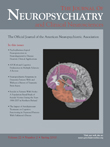Delusion of Cotard’s Syndrome Successfully Treated with a Dopamine Agonist
To the Editor: Cotard’s syndrome, which is characterized by delusions of negation and increased anxiety accompanied by severe depressive symptoms, is reported to be resistant to antidepressants. Although delusions are treated with neuroleptics, Cotard’s syndrome responds poorly to dopamine antagonists. Several case studies have recommended that ECT most effectively ameliorates Cotard’s syndrome. 1 In this article, we describe the case of a patient with Cotard’s syndrome that was successfully treated with dopamine augmentation therapy for treatment-resistant depression. 2
Case Report
A 58-year-old woman had been diagnosed with recurrent major depression and treated with antidepressants for about 25 years. No hypomanic-to-manic episode or depressive episode with psychotic features had been observed. Because of irregular oral administration of psychotropic drugs during the remission period, she experienced a relapse of depression twice in 5 years. The present episode was that of severe depression with psychotic features. Her delusional complaints were “I cannot eat any food, because my mouth does not salivate. I would never be able to get out of the hospital. I have no money to pay for my hospital stay. My mother is dead. My mind is completely blank with no thoughts, and there seems to be no brain in my head. I would have to stay bare all my life, because I have no clothes. I cannot sleep for a moment. I cannot talk because I have lost all my words.” Suicidal ideation, anxiety, loss of interest and pleasure, agitation, weight loss of 6 kg in 2 months, and depressive mood were observed. Paroxetine (up to 40 mg/day) was administered for 36 days from the time of admission, but no improvement was observed. For augmentation for treatment-resistant depression, pramipexole (up to 0.75 mg/day) was administered as a dopamine agonist in addition to paroxetine. The depressive symptoms, including appetite loss and agitation, improved 6–9 days after the augmentation, and no worsening of delusional symptoms was observed. The delusions disappeared at 14 days after the initiation of the augmentation. No relapse of delusion and depression was observed during the 8-week follow-up period. Paroxetine, 20 mg/day, and pramipexole, 0.75 mg/day, were administered at the time of discharge.
Discussion
This is the second case report indicating the effectiveness of dopamine agonist augmentation therapy for treating delusions of Cotard’s syndrome. Although bromocriptine was added to clomipramine in the previous study, 3 pramipexole was chosen as the dopamine agonist 4 to avoid fibrotic cardiac valvulopathy by ergot alkaloids. The effectiveness of additional neuroleptics for the treatment of psychotic depression has also been reported. 5 Few studies, however, have addressed the effectiveness of neuroleptics in the treatment of Cotard’s syndrome. For over a hundred years, Cotard’s syndrome has survived as a distinct psychopathological diagnostic entity. The present case indicated the existence of a group of patients with psychotic depression whose depression needs to be treated first, even by enhancing dopamine activities. Considering the fact that ECT is generally ineffective in treating delusions, this case indicated the importance of treating severe depression first in Cotard’s syndrome.
1. Mahgoub NA, Hossain A: Cotard’s syndrome and electroconvulsive therapy. Psychiatr Serv 2004; 55:1319Google Scholar
2. Inoue T, Tsuchiya K, Miura J, et al: Bromocriptine treatment of tricyclic and heterocyclic antidepressant-resistant depression. Biol Psychiatry 1996; 40:151–153Google Scholar
3. Kondo S, Hayashi H, Eguchi T, et al: Bromocriptine augmentation therapy in a patient with Cotard’s syndrome. Prog Neuropsychopharmacol Biol Psychiatry 2003; 27:719–721Google Scholar
4. Aiken CB: Pramipexole in psychiatry: a systematic review of the literature. J Clin Psychiatry 2007; 68:1230–1236Google Scholar
5. Goto M, Yoshimura R, Kakihara S, et al: Risperidone in the treatment of psychotic depression. Prog Neuropsychopharmacol Biol Psychiatry 2006; 30:701–707Google Scholar



